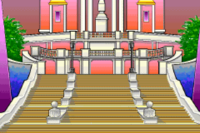Spanish Steps: Difference between revisions
From the Super Mario Wiki, the Mario encyclopedia
Jump to navigationJump to search
m (Text replacement - "Category:Mario is Missing! Landmarks" to "Category:Mario is Missing! landmarks") |
mNo edit summary |
||
| Line 1: | Line 1: | ||
__NOTOC__ | __NOTOC__ | ||
[[File:Spanish Steps MIMDOS.png|thumb|The Spanish Steps in the DOS version]] | [[File:Spanish Steps MIMDOS.png|thumb|The Spanish Steps in the DOS version]] | ||
The '''{{wp|Spanish Steps}}''' are a set of stairs near the {{wp|Trinità dei Monti}} church and the {{wp|Spain|Spanish}} Embassy to the {{wp|Holy See}} (and not {{wp|Vatican City}} as the pamphlet says) that lends its name to the landmark. It is also one of two landmarks in [[Rome]], alongside the [[Pantheon]], that are exclusive to the PC version of ''[[Mario is Missing!]]''. It is also one of the five locations within Rome that get attacked by [[Koopa Troopa]]s; they take one of the two [[Bannister]]s, causing the entire stairs to be closed. Luigi allows the steps to be reopened by grabbing back the | {{quote2|The Spanish Steps and the piazza (plaza) it encompasses were actually built with French, not Spanish, money. The steps and the plaza take their misleading names from the Spanish Embassy to the Vatican. Wide and comfortably curved, these twin staircases are famous for their popularity with sunbathers, skateboards and tourists. The famous poet, Keats, once lived nearby.|Pamphlet|''[[Mario is Missing!]]''}} | ||
The '''{{wp|Spanish Steps}}''' are a set of stairs near the {{wp|Trinità dei Monti}} church and the {{wp|Spain|Spanish}} Embassy to the {{wp|Holy See}} (and not {{wp|Vatican City}} as the pamphlet says) that lends its name to the landmark. It is also one of two landmarks in [[Rome]], alongside the [[Pantheon]], that are exclusive to the PC version of ''[[Mario is Missing!]]''. It is also one of the five locations within Rome that get attacked by [[Koopa Troopa]]s; they take one of the two [[Bannister from the Spanish Steps|bannister]]s, causing the entire stairs to be closed. Luigi allows the steps to be reopened by grabbing back the bannister and returning it to its rightful place, although the clerk at the information booth verifies the Bannister's authenticity first by asking Luigi some questions. These include: | |||
*''Watch your step, Luigi! How many stairs make up the Spanish Steps?'' | *''Watch your step, Luigi! How many stairs make up the Spanish Steps?'' | ||
| Line 14: | Line 15: | ||
**'''The Spanish Embassy''' | **'''The Spanish Embassy''' | ||
{{br|left}} | {{br|left}} | ||
==Media== | ==Media== | ||
| Line 26: | Line 25: | ||
==Trivia== | ==Trivia== | ||
*Although the pamphlet says that the staircase was paid with | *Although the pamphlet says that the staircase was paid with French money, this is incorrect. The money was left by French diplomat Étienne Gueffier in his will, but it was in {{wp|Italian scudo|scudi}}, a deprecated Italian coin.<ref>Elling, Christian. ''Rome: The Biography of Her Architecture from Bernini to Thorvaldsen'', illustrated ed., Westview Press, 1975, p. 328. ''Google Books'', books.google.ca/books?id=rOxPAAAAMAAJ.</ref>. | ||
==References== | ==References== | ||
Revision as of 23:10, October 22, 2022
Template:Quote2 The Spanish Steps are a set of stairs near the Trinità dei Monti church and the Spanish Embassy to the Holy See (and not Vatican City as the pamphlet says) that lends its name to the landmark. It is also one of two landmarks in Rome, alongside the Pantheon, that are exclusive to the PC version of Mario is Missing!. It is also one of the five locations within Rome that get attacked by Koopa Troopas; they take one of the two bannisters, causing the entire stairs to be closed. Luigi allows the steps to be reopened by grabbing back the bannister and returning it to its rightful place, although the clerk at the information booth verifies the Bannister's authenticity first by asking Luigi some questions. These include:
- Watch your step, Luigi! How many stairs make up the Spanish Steps?
- None, it's an escalator
- 328
- 3280
- 238
- From what did the Spanish Steps take their misleading name?
- Cocker spaniels
- The Spanish Civil War
- The Spanish Embassy
Media
| File info 0:08 |
Trivia
- Although the pamphlet says that the staircase was paid with French money, this is incorrect. The money was left by French diplomat Étienne Gueffier in his will, but it was in scudi, a deprecated Italian coin.[1].
References
- ^ Elling, Christian. Rome: The Biography of Her Architecture from Bernini to Thorvaldsen, illustrated ed., Westview Press, 1975, p. 328. Google Books, books.google.ca/books?id=rOxPAAAAMAAJ.
